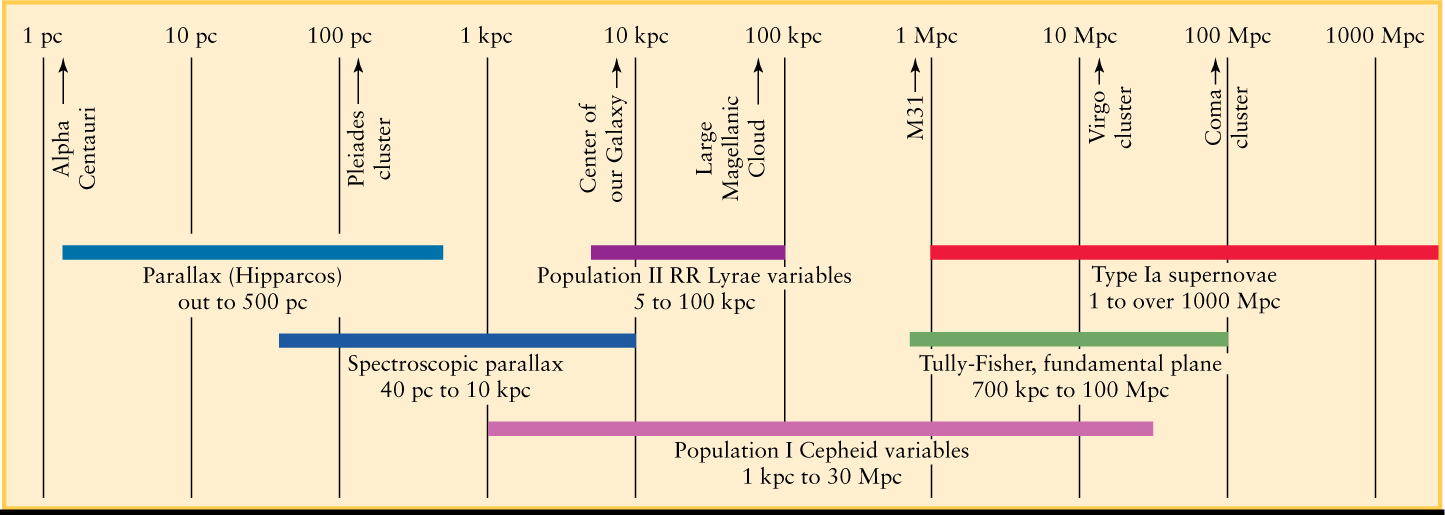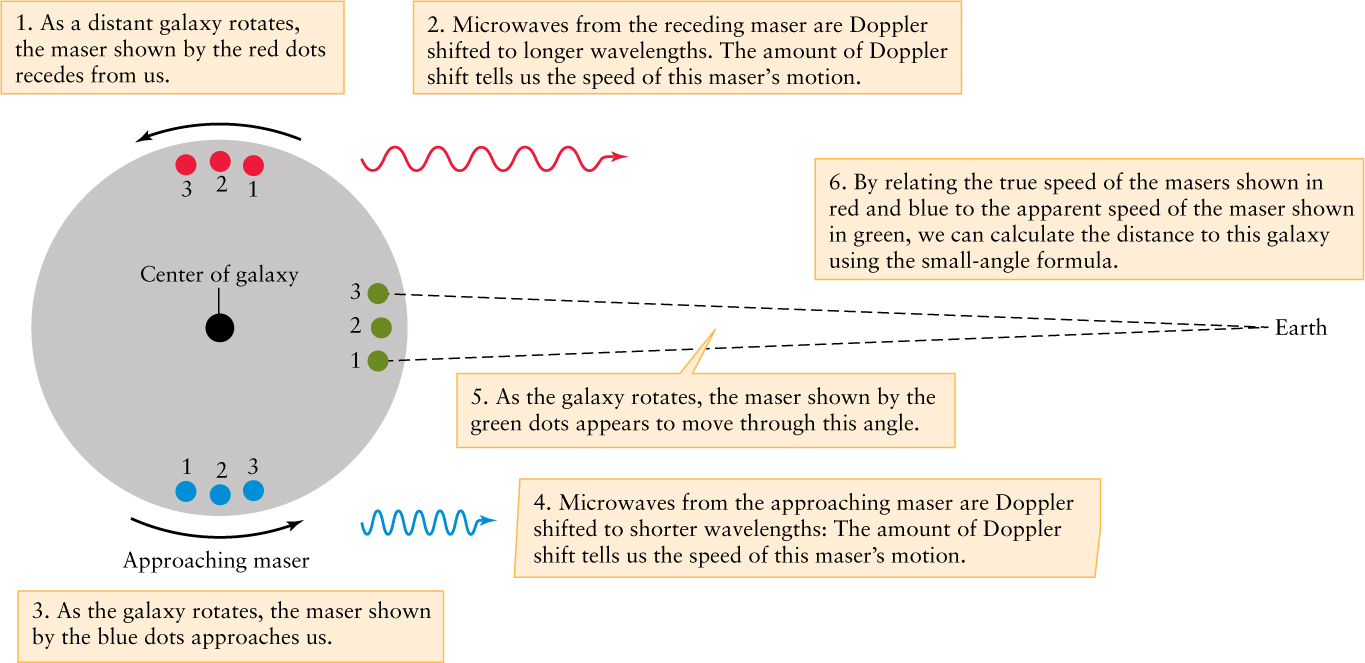23-4 Astronomers use various techniques to determine the distances to remote galaxies
The various methods of distance determination are interrelated because one is used to calibrate another
A key question that astronomers ask about galaxies is “How far away are they?” Knowing the distances to galaxies is essential for learning the structure and history of the universe. Unfortunately, many of the techniques that are used to measure distances within our Milky Way Galaxy cannot be used for the far greater distances to other galaxies. The extremely accurate parallax method that we described in Section 17-1 can be used only for stars within about 500 pc. Beyond that distance, parallax angles become too small to measure. Spectroscopic parallax, in which the distance to a star or star cluster is found with the help of the H-R diagram (see Section 17-8), is accurate only out to roughly 10 kpc from Earth; more distant stars or clusters are too dim to give reliable results.
676
Standard Candles: Variable Stars and Type Ia Supernovae
To determine the distance to a remote galaxy, astronomers look instead for a standard candle—an object, such as a star, that lies within that galaxy and for which we know the luminosity (or, equivalently, the absolute magnitude, described in Section 17-3). By measuring how bright the standard candle appears, astronomers can calculate its distance—and hence the distance to the galaxy of which it is part—using the inverse-square law.
The challenge is to find standard candles that are luminous enough to be seen across the tremendous distances to galaxies. To be useful, standard candles should have four properties:
- They should be luminous so that we can see them out to great distances.
- We should be fairly certain about their luminosities so that we can be equally certain of any distance calculated from a standard candle’s apparent brightness and luminosity.
- They should be easily identifiable—for example, by the shape of the light curve of a variable star.
- They should be relatively common so that astronomers can use them to determine the distances to many different galaxies.
For nearby galaxies, Cepheid variable stars make reliable standard candles. These variables can be seen out to about 30 Mpc (100 million ly) using the Hubble Space Telescope, and their luminosity can be determined from their period through the period-luminosity relation depicted in Figure 19-20. Box 23-1 gives an example of using Cepheid variables to determine distances. RR Lyrae stars, which are Population II variable stars often found in globular clusters, can be used as standard candles in a similar way. (We saw in Section 22-1 how RR Lyrae variables helped determine the size of our Galaxy.) Because they are less luminous than Cepheids, RR Lyrae variables can be seen only out to 100 kpc (300,000 ly).
Beyond about 30 Mpc even the brightest Cepheid variables, which have luminosities of about 2 × 104 L⊙, fade from view. Astronomers have tried to use even more luminous stars such as blue supergiants to serve as standard candles. However, this idea is based on the assumption that there is a fixed upper limit on the luminosities of stars, which may not be the case. Hence, these standard candles are not very “standard,” and distances measured in this way are somewhat uncertain.
One class of standard candles that astronomers have used beyond 30 Mpc is Type Ia supernovae. As we described in Section 20-9, these supernovae occur when a white dwarf in a close binary system accretes enough matter from its companion to blow itself apart in a thermonuclear conflagration. A Type Ia supernova can reach a maximum luminosity of about 3 × 109 L⊙ (Figure 23-13). If a Type Ia supernova is seen in a distant galaxy and its maximum apparent brightness measured, the inverse-square law can be used to find the galaxy’s distance (see Box 23-1).

One complication is that not all Type Ia supernovae are equally luminous. Fortunately, there is a simple relationship between the peak luminosity of a Type Ia supernova and the rate at which the luminosity decreases after the peak: The more slowly the brightness decreases, the more luminous the supernova. Using this relationship, astronomers have measured distances to supernovae more than 1000 Mpc (3 billion ly) from Earth.
677
Unfortunately, this technique can be used only for galaxies in which we happen to observe a Type Ia supernova. But telescopic surveys now identify many dozens of these supernovae every year, so the number of galaxies whose distances can be measured in this way is continually increasing.
CONCEPT CHECK 23-6
Imagine that a thin cloud of intergalactic dust reduced the observed brightness of a Type Ia supernova found in a distant galaxy. Would astronomers who did not know the dust was there mistakenly assume that the galaxy is farther or closer than it actually is?
Distance Determination without Standard Candles
Other methods for determining the distances to galaxies do not make use of standard candles. One was discovered in the 1970s by the astronomers Brent Tully and Richard Fisher. They found that the width of the hydrogen 21-cm emission line of a spiral galaxy (see Section 22-3) is related to the galaxy’s luminosity. This correlation is the Tully-Fisher relation—the broader the line, the more luminous the galaxy.
Such a relationship exists because radiation from the approaching side of a rotating galaxy is blueshifted while that from the galaxy’s receding side is redshifted. Thus, the 21-cm line is Doppler broadened by an amount directly related to how fast a galaxy is rotating. Rotation speed is related to the galaxy’s mass by Newton’s form of Kepler’s third law. The more massive a galaxy, the more stars it contains and thus the more luminous it is. Consequently, the width of a galaxy’s 21-cm line is directly related to its luminosity.
Because line widths can be measured quite accurately, astronomers can use the Tully-Fisher relation to determine the luminosity of a distant spiral galaxy. By combining this information with measurements of apparent brightness, they can calculate the distance to the galaxy. This technique can be used to measure distances of 100 Mpc or more.
Elliptical galaxies do not rotate, so the Tully-Fisher relation cannot be used to determine their distances. But in 1987 the American astronomers Marc Davis and George Djorgovski pointed out a correlation between the size of an elliptical galaxy, the average motions of its stars, and how the galaxy’s brightness appears distributed over its surface.
In geometry, three points define a plane, so the relationship among size, motion, and brightness is called the fundamental plane. By measuring the last two quantities, an astronomer can use the fundamental plane relationship to determine a galaxy’s actual size. And by comparing this to the galaxy’s apparent size, the astronomer can calculate the distance to the galaxy using the small-angle formula (see Box 1-1). Ellipticals can be substantially larger and more luminous than spirals, so the fundamental plane can be used at somewhat greater distances than can the Tully-Fisher relation.
CONCEPT CHECK 23-7
Is a galaxy that appears to be quite bright, yet has a narrow width for its emitted hydrogen light, relatively close or very distant from our own Galaxy?
The Distance Ladder
Figure 23-14 shows the ranges of applicability of several important means of determining astronomical distances. Because these ranges overlap, one technique can be used to calibrate another. As an example, astronomers have studied Cepheids in nearby galaxies that have also been host to Type Ia supernovae. The Cepheids provide the distances to these nearby galaxies, making it possible to determine the peak luminosity of each supernova using its maximum apparent brightness and the inverse-square law. Once the peak luminosity is known, it can be used to determine the distance to Type Ia supernovae in more distant galaxies. Because one measuring technique leads us to the next one like rungs on a ladder, the techniques shown in Figure 23-14 (along with others) are referred to collectively as the distance ladder.

678
ANALOGY
If you give a slight shake to the bottom of a tall ladder, the top can wobble back and forth alarmingly. A change in distance-measuring techniques used for nearby objects can also have substantial effects on the distances to remote galaxies. For instance, if astronomers discovered that the distances to nearby Cepheids were in error, distance measurements using any technique that is calibrated by Cepheids would be affected as well. (As an example, the distance to the galaxy M100 shown in Figure 23-4 is determined using Cepheids. A Type Ia supernova has been seen in M100, as Figure 23-13 shows, and its luminosity is determined using the Cepheid-derived distance to M100. Any change in the calculated distance to M100 would change the calculated luminosity of the Type Ia supernova, and so it would have an effect on all distances derived from observations of how bright these supernovae appear in other galaxies.) For this reason, astronomers go to great lengths to check the accuracy and reliability of their standard candles.
One distance-measuring technique that has broken free of the distance ladder uses observations of molecular clouds called masers. (“Maser” is an acronym for “microwave amplification by stimulated emission of radiation.”) Just as an electric current stimulates a laser to emit an intense beam of visible light, nearby luminous stars can stimulate water molecules in a maser to emit intensely at microwave wavelengths. This radiation is so intense that masers can be detected millions of parsecs away.
During the 1990s, Jim Herrnstein and his collaborators used the Very Long Baseline Array (see Section 6-6) to observe a number of masers orbiting in a disk around the center of the spiral galaxy M106. They determined the orbital speed of the masers from the Doppler shift of masers near the edges of the disk, where they are moving most directly toward or away from Earth. They also measured the apparent change in position of masers moving across the face of M106. By relating this apparent speed to the true speed determined from the Doppler shift, they calculated that the masers and the galaxy of which they are part are 7.2 Mpc (23 million ly) from Earth (Figure 23-15).

The maser technique is still in its infancy. But because this technique is independent of all other distance-measuring methods, it is likely to play an important role in calibrating the rungs of the distance ladder.
CONCEPT CHECK 23-8
Which of the rungs on the distance ladder depends on an accurate measurement of parallax?